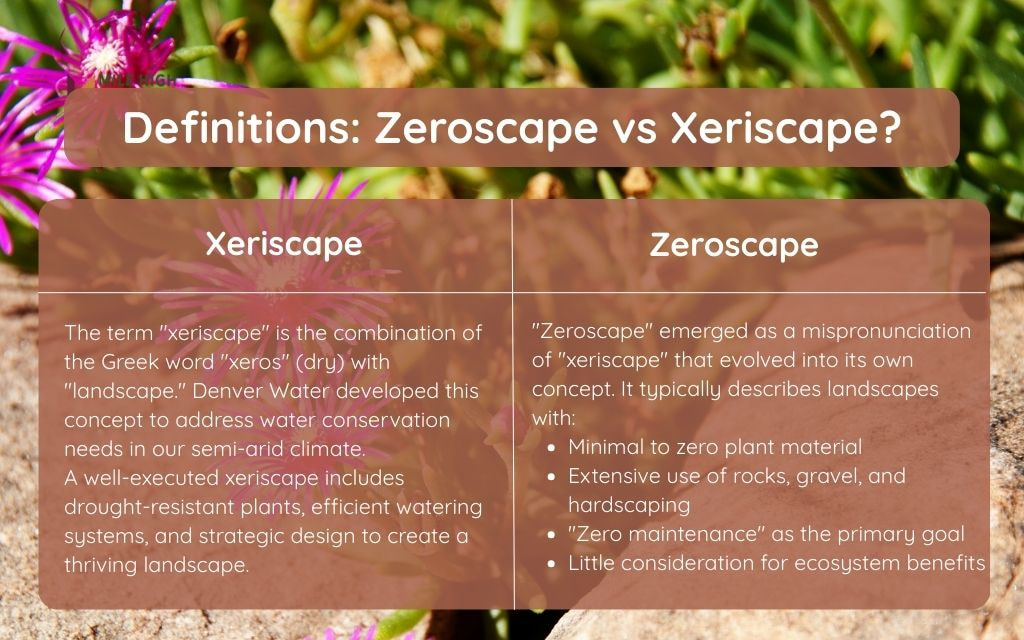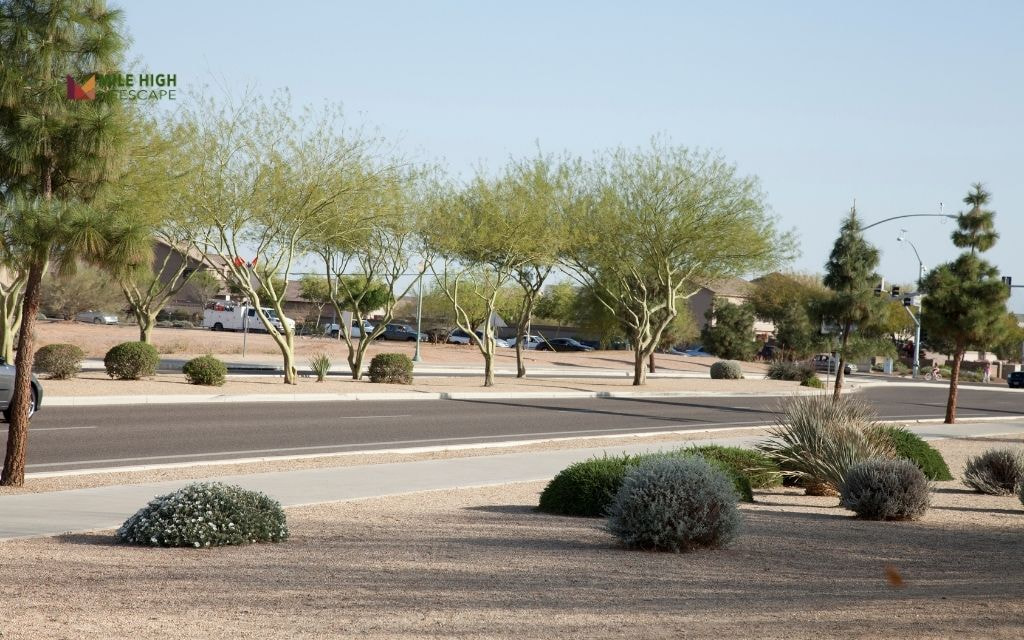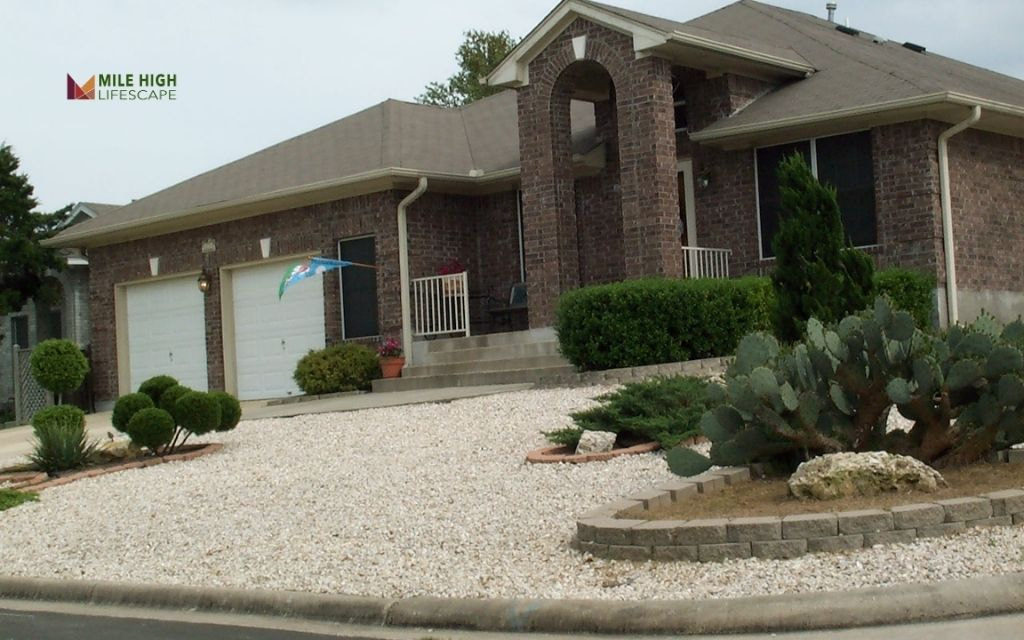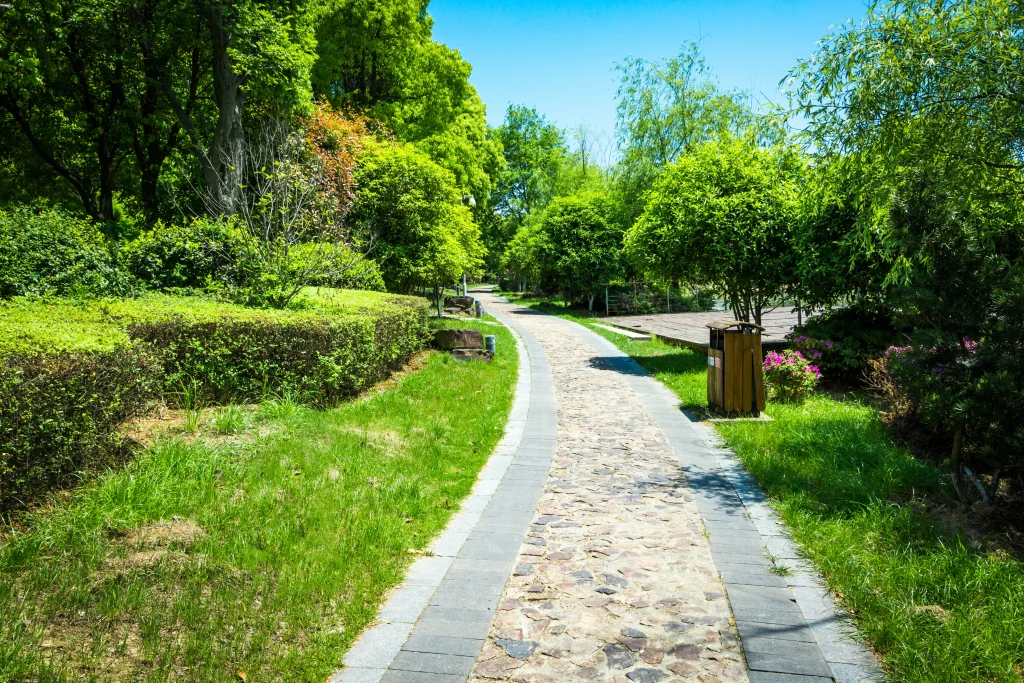When considering water-conscious landscaping options, “xeriscape” and “zeroscape” often enter the conversation and cause confusion. What’s different about zeroscape vs xeriscape?
Xeriscaping involves using drought-tolerant plants and water-efficient techniques to create landscapes that conserve water. Zeroscape, despite its widespread usage, isn’t a formal landscaping term at all. It refers to minimalist designs featuring hardscaping elements like rocks and gravel with virtually no plants.
Understanding these differences helps Denver homeowners make informed decisions that align with both their maintenance preferences and our region’s unique climate conditions.
Definitions: Zeroscape vs Xeriscape?
Xeriscape
The term “xeriscape” is the combination of the Greek word “xeros” (dry) with “landscape.” Denver Water developed this concept to address water conservation needs in our semi-arid climate.
True xeriscaping incorporates 7 principles:
- Planning and design
- Soil improvement
- Efficient irrigation
- Appropriate plant selection
- Mulching
- Limited turf areas
- Proper maintenance
A well-executed xeriscape includes drought-resistant plants, efficient watering systems, and strategic design to create a thriving landscape that requires significantly less water than traditional yards.
Zeroscape
“Zeroscape” emerged as a mispronunciation of “xeriscape” that evolved into its own concept. It typically describes landscapes with:
- Minimal to zero plant material
- Extensive use of rocks, gravel, and hardscaping
- “Zero maintenance” as the primary goal
- Little consideration for ecosystem benefits
This approach focuses on eliminating maintenance rather than balancing water conservation with ecological benefits.

Side-by-Side Comparison: Xeriscape vs Zeroscape
| Feature | Xeriscape | Zeroscape |
| Primary Purpose | Reduces water usage (50-75%) while creating visually appealing landscapes through smart planning | Eliminates all maintenance and water requirements by removing living elements |
| Plant Life | Incorporates selected native and drought-resistant species that thrive with minimal water | Contains few to no plants, relying instead on inorganic materials like rocks and gravel |
| Aesthetic | Creates varied, colorful, and multi-layered landscapes that change with the seasons | Produces sparse, minimalist environments with consistent appearance year-round |
| Wildlife Benefits | Supports local pollinators (bees, butterflies), birds, and beneficial insects with food and habitat | Offers minimal ecological value with few resources for native wildlife |
| Soil Health | Enhances soil quality through mulching, proper amendments, and organic matter | Often leaves soil compacted, covered, or neglected beneath hardscape materials |
| Water Usage | Strategically reduces irrigation needs through efficient systems and plant selection | Nearly eliminates water use by removing elements requiring irrigation |
| Long-term Value | Generally improves property values by creating attractive, sustainable landscapes | May reduce curb appeal and market value unless executed with exceptional design |
| Maintenance Needs | Requires periodic, seasonal attention but significantly less than traditional lawns | Demands minimal ongoing maintenance beyond occasional weed control |
| Temperature Impact | Helps moderate property temperature through plant transpiration and shade | Can increase heat reflection and ambient temperature around structures |
Each approach serves different priorities, with xeriscaping balancing water conservation with living landscapes while zeroscaping prioritizes maintenance elimination over ecological benefits.
Xeriscaping: The Pros and Cons
Pros
Here are substantial benefits of xeriscaping delivers for Denver homeowners:
- Water conservation remains the primary advantage, with potential savings between 50-75% compared to traditional lawns. This translates directly to lower water bills and reduced resource consumption.
- These landscapes support local ecosystems by providing habitat for pollinators and birds.
- Native Colorado plants thrive in our climate without artificial support systems, creating resilient outdoor spaces.
- The reduced maintenance means less mowing, fertilizing, and pest control. Once established, xeric plants need minimal intervention to flourish.
- Property value increases with well-designed xeriscapes. Denver real estate increasingly values sustainable, climate-appropriate landscaping as water becomes more precious.
Cons
Xeriscaping isn’t without challenges:
- The initial installation of xeriscaping costs exceed traditional landscaping.
- Professional design and installation for a comprehensive xeriscape typically requires greater upfront investment.
- Establishment periods require patience. Most xeriscapes take 2-3 years to fully mature and achieve maximum water efficiency.
- Design expertise matters significantly. Without proper planning, xeriscapes can appear disorganized or sparse until plants mature.

Zeroscaping: The Pros and Cons
Pros
Minimal Ongoing Costs
Once installed, zeroscaped areas eliminate recurring expenses. With no plants to water, you’ll save 100% on irrigation costs compared to traditional lawns, potentially reducing water bills by $300-600 annually for a typical Denver yard.
Without living components, you’ll avoid expenses for fertilizers, pest controls, and seasonal plant replacements that even xeriscaping might occasionally require.
Solution for Challenging Areas
Zeroscaping excels in spaces where plants struggle to thrive. Narrow side yards with poor sunlight, areas beneath roof overhangs that block rainfall, spaces near heat-producing units, or zones with poor soil quality can be transformed from problem areas into clean, defined spaces with decorative rock or gravel installations.
Consistent Year-Round Appearance
Unlike living landscapes that change with seasons, zeroscaped areas maintain a uniform look throughout the year. This predictability appeals to homeowners who travel or prefer unchanging aesthetics. What you see at installation remains identical throughout summer heat, winter snow, and everything between.
Lower Initial Installation Costs
This price advantage comes from eliminating expenses for plants, irrigation modifications, and soil amendments. For budget-conscious homeowners, this approach delivers immediate financial benefits without waiting for long-term water savings to offset costs.
Zero Specialized Knowledge Required
While effective xeriscaping demands understanding of plant needs and water requirements, zeroscaping requires minimal horticultural knowledge. This simplicity makes it accessible for novice homeowners uncertain about plant selection or maintenance practices.
Cons
Heat Island Effect
Rocks and gravel absorb and radiate significantly more heat than living landscapes. During Denver summers, zeroscaped areas can reach temperatures 15-20°F higher than planted zones. This heat reflection increases cooling costs for adjacent buildings and creates uncomfortable outdoor environments during warmer months.
Limited Ecological Value
Without plants, zeroscaped areas provide no habitat, food, or shelter for wildlife. This creates “dead zones” from an ecological perspective, contributing nothing to pollinator support, oxygen production, or carbon sequestration.
Aesthetic Harshness
Even well-executed zeroscapes often create visually harsh environments that feel industrial rather than inviting. Real estate professionals report that extensive zeroscaping can reduce property values compared to attractive xeriscaping.

Runoff and Erosion Issues
Without plant roots to anchor soil and absorb rainfall, zeroscaped areas increase water runoff during storms. This additional runoff contributes to local drainage problems, erosion, and potential water quality issues as surface water moves across hardscaped areas collecting pollutants before entering waterways.
Rebate Ineligibility
Most water conservation incentive programs explicitly exclude zeroscaping from rebate eligibility. Denver Water and similar agencies focus on sustainable water reduction rather than water elimination, recognizing the environmental trade-offs of completely removing living landscapes.
Which Approach Suits Your Denver Property?
Choose Xeriscaping If:
- You value both water conservation and landscape beauty. Xeriscaping delivers substantial water savings while maintaining vibrant outdoor spaces throughout the seasons.
- Environmental benefits matter to you. Supporting pollinators, birds, and local ecosystems aligns with xeriscaping principles.
- You qualify for water rebates. Denver Water offers incentives for properly designed xeriscapes that meet specific criteria.
- Long-term property value drives your decisions. Well-executed xeriscaping ideas increasingly appeal to Colorado homebuyers seeking sustainable homes.
Consider Zeroscaping For:
- Utility areas need functional, low-intervention solutions. Areas around HVAC units, narrow side yards, or other challenging spaces sometimes benefit from this approach.
- You need truly maintenance-free zones. Some property sections might justify this ultra-low-maintenance approach when balanced with living landscapes elsewhere.
- Small accent areas complement your overall design. Used judiciously, zero-plant zones can provide visual contrast within broader xeriscaped yards.
Conclusion
Denver’s unique climate presents challenges and opportunities for sustainable landscaping. The Front Range receives approximately 15 inches of precipitation annually – half the national average – making water-conscious landscaping essential.
Xeriscaping aligns perfectly with our semi-arid conditions, utilizing plants adapted to thrive in our environment while conserving precious water resources. The approach mirrors natural ecosystems found throughout Colorado, creating landscapes that harmonize with our regional climate patterns.
While zeroscaping eliminates water usage entirely, it fails to contribute to the broader environmental benefits that make xeriscaping truly sustainable. The ecological value of living plants represents irreplaceable functions that rocks alone cannot provide.
Let Mile High Lifescape Help
Mile High Lifescape specializes in designing and implementing xeriscapes that balance water conservation with beautiful, functional outdoor spaces. Our team brings nearly 2 decades of experience transforming Denver properties into low-maintenance landscapes that thrive in our unique climate.
“Contact us today at (303) 877-9091 or hello@milehighlifescape.com to schedule a consultation and explore how our xeriscape landscaping services can enhance your property while conserving water
Frequently Asked Questions (FAQs)
Is “zeroscape” a real term?
“Zeroscape” originated as a mispronunciation of “xeriscape” but evolved into shorthand for minimalist, plant-free landscapes. Professional landscapers generally avoid this term since it doesn’t represent formal landscaping methodology.
Which approach saves more water in Colorado?
While zeroscaping technically uses less water by eliminating plants entirely, xeriscaping represents the more balanced approach. Xeriscaping reduces water consumption by 50-75% while maintaining ecological benefits that contribute to broader environmental sustainability.
Can I xeriscape part of my lawn and keep grass in other areas?
Yes, partial xeriscaping works effectively for many Denver properties. Strategic turf placement in functional areas (play spaces, gathering zones) combined with xeric plantings elsewhere creates balanced landscapes that conserve water while meeting practical needs.
Is zeroscaping allowed in Denver residential areas?
Yes, zeroscaping remains permitted in Denver residential zones, but homeowners should verify HOA restrictions before proceeding. Colorado law prevents HOAs from prohibiting xeriscaping but allows for design guidelines that might impact completely plant-free landscapes.
